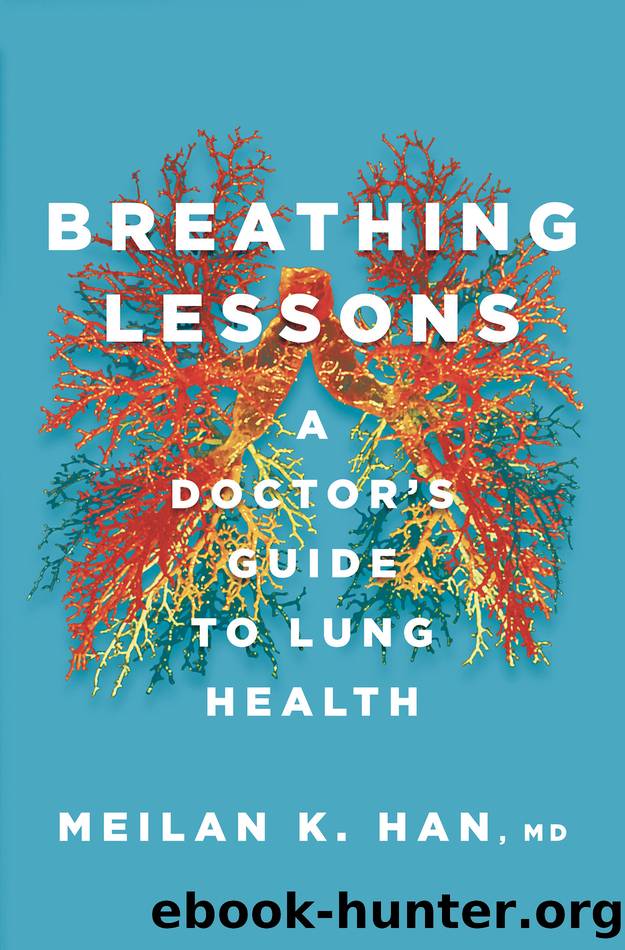Breathing Lessons by Meilan K. Han

Author:Meilan K. Han [Han, Meilan K.]
Language: eng
Format: epub
The Medical Interview
Even with our incredible advances in technology, obtaining an accurate medical history is still key to making an accurate diagnosis. Traditionally, the medical interview for all physicians is quite structured. This includes the history of the present illness together with the patientâs past medical history, including any prior diagnoses and surgeries. We create a list of current medications, specifying any allergies to medications. We also typically ask about the patientâs social history, which includes occupations, tobacco and alcohol use, and travel history, as well as any family history of medical problems. Finally, we perform a review of systems, where we ask about symptoms from all major organ systems that may not have come up earlier in the interview.
The primary respiratory symptoms lung physicians will ask about include shortness of breath and cough. Shortness of breath, or dyspnea as lung doctors like to call it, is a complicated sensation. In reality, it is poorly understood. And besides pulmonary conditions, cardiac, metabolic, and neuromuscular disorders can also cause dyspnea. Dyspnea is also tricky to assess because human beings avoid discomfort. So if an activity makes someone short of breath, they will often simply stop doing it. Hence, when asked if they are short of breath, some patients will answer ânoâ without providing a completely accurate picture of their respiratory health. For instance, a patient may deny shortness of breath, but upon further questioning tell me that they used to walk the golf course but now need to use a cart. These are the kinds of details I need.
Time course is also important. A change in symptoms over time suggests that whatever the problem is, itâs getting better or worse. Dyspnea that is sudden in onset might suggest a collapsed lung or blood clot to the lung. I once interviewed a patient who could tell me the exact day and time when his dyspnea started, two years earlier when heâd fallen off a ladder. This led me to look for a paralyzed diaphragm, which in his case was caused by neck injury from the fall. The phrenic nerve takes off from spinal nerve roots at the level of the 3rd, 4th, and 5th vertebrae in the neck and hence is at risk for damage with neck injuries. Shortness of breath that occurs only with certain exposures, such as dusts, molds, and perfumes, or with exercise can be seen in asthma. Breathlessness that wakes a patient from sleep can occur from heart failure, but also from pooling of respiratory secretions. Breathlessness that occurs only when lying down, the supine position, points to some type of neuromuscular dysfunction.
Cough is another important pulmonary symptom. For most of us, coughing is associated with upper respiratory tract infections and is short lived. Cough that lasts longer can be related to things like postnasal drip, asthma, and heartburn. Certain types of medications, most notoriously a class of antihypertensive medications called ACE inhibitors, can also cause a cough. Physicians typically want to know not only how long the
Download
This site does not store any files on its server. We only index and link to content provided by other sites. Please contact the content providers to delete copyright contents if any and email us, we'll remove relevant links or contents immediately.
Spare by Prince Harry The Duke of Sussex(4198)
Machine Learning at Scale with H2O by Gregory Keys | David Whiting(2291)
Fairy Tale by Stephen King(2070)
Will by Will Smith(2042)
Hooked: A Dark, Contemporary Romance (Never After Series) by Emily McIntire(1959)
Rationality by Steven Pinker(1765)
The Bullet Journal Method by Ryder Carroll(1502)
The Becoming by Nora Roberts(1330)
Friends, Lovers, and the Big Terrible Thing by Matthew Perry(1328)
A Short History of War by Jeremy Black(1300)
HBR's 10 Must Reads 2022 by Harvard Business Review(1256)
The Strength In Our Scars by Bianca Sparacino(1247)
Can't Hurt Me: Master Your Mind and Defy the Odds - Clean Edition by David Goggins(1227)
515945210 by Unknown(1208)
Fear No Evil by James Patterson(1109)
Love on the Brain by Ali Hazelwood(1097)
Bewilderment by Richard Powers(1083)
This Family Does It by Kevin Sellers(1080)
443319537 by Unknown(1073)
